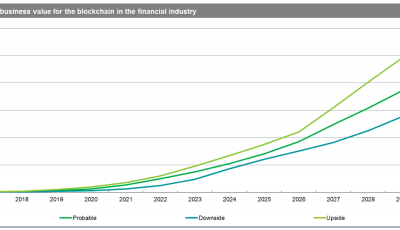Bitcoin in 2016
 The past year was a whirlwind for bitcoin and the bitcoin ecosystem. Scams and hacks, government regulation, new launches and new investors, and a price that started in the basement but ended relatively positively. The year ahead promises to be a year of potential; will bitcoin achieve greater success in ‘going mainstream’? Will the price improve? What will become of bitcoin-based businesses? I’ll take a stab at predicting the future in this look ahead at bitcoin in 2016.
The past year was a whirlwind for bitcoin and the bitcoin ecosystem. Scams and hacks, government regulation, new launches and new investors, and a price that started in the basement but ended relatively positively. The year ahead promises to be a year of potential; will bitcoin achieve greater success in ‘going mainstream’? Will the price improve? What will become of bitcoin-based businesses? I’ll take a stab at predicting the future in this look ahead at bitcoin in 2016.
Bitcoin has struggled to achieve mainstream adoption. Long forecasted by bitcoin believers, the move into the mainstream has yet to materialize, and the reasons are many. The lack of mainstream appeal boils down to two real issues: Lack of a strong use case and difficulty in understanding bitcoin use and security. For all that bitcoin does well, the strongest appeal of bitcoin is not to the average Joe, but rather the average libertarian or anti-government anarchist. This tiny segment of the population enthusiastically endorses bitcoin, but, much like Ron Paul, this doesn’t catch on with the mainstream. Second to this is that these fringe political interests tend to be young and technically savvy, believing in the power of cryptography to alleviate the prodding of government in private business. The technical ability of bitcoin believers, or at least the willingness to adopt and learn new technologies, is also not shared by the larger population. Especially when it comes to handling their money. Unless bitcoin can do two things this year, demonstrate a clear use case and create a user interface that doesn’t rely on highly-technical knowledge for security, bitcoin will remain on the fringe.
 The price of bitcoin is a longstanding point of contention. What drives the price? In reality, no one knows. The fake volume of major exchanges may artificially prop up the price, like the famed Willy-bot at Mt. Gox. The price may also be driven by miners selling or holding their coins. Because no true measure of liquidity is available, the bitcoin ecosystem operates in the unknown. The price won’t move after apparently important events, but will move dramatically for no salient reason. This makes predicting the bitcoin price particularly challenging. There is also the school of thought that bitcoin’s price doesn’t matter, and the point of bitcoin is not the price but rather the disruptive nature of the technology. Either way, my prediction for the price is somewhere in the middle. I think the price will fluctuate between 350-450 with several spikes and plunges, but settle around $400 by the end of the year. Why? The institutional interest in bitcoin is driving mining efforts, and the strong interest of mining operations in the price will dictate how they handle the sale of coins. The effort by the largest exchanges to appear massively liquid, though absurdly fake, will continue to prop the price up. The same exchanges will be wary of driving the price too high, though, and going the route of Mt. Gox. Of course this could all be proved moot if flaws are found in the protocol, if more scandals occur, or if a major exchange is found to be insolvent. The unknowns of bitcoin price movements increase the risk of rapid price fluctuations, but I think this year will be less volatile than previous years.
The price of bitcoin is a longstanding point of contention. What drives the price? In reality, no one knows. The fake volume of major exchanges may artificially prop up the price, like the famed Willy-bot at Mt. Gox. The price may also be driven by miners selling or holding their coins. Because no true measure of liquidity is available, the bitcoin ecosystem operates in the unknown. The price won’t move after apparently important events, but will move dramatically for no salient reason. This makes predicting the bitcoin price particularly challenging. There is also the school of thought that bitcoin’s price doesn’t matter, and the point of bitcoin is not the price but rather the disruptive nature of the technology. Either way, my prediction for the price is somewhere in the middle. I think the price will fluctuate between 350-450 with several spikes and plunges, but settle around $400 by the end of the year. Why? The institutional interest in bitcoin is driving mining efforts, and the strong interest of mining operations in the price will dictate how they handle the sale of coins. The effort by the largest exchanges to appear massively liquid, though absurdly fake, will continue to prop the price up. The same exchanges will be wary of driving the price too high, though, and going the route of Mt. Gox. Of course this could all be proved moot if flaws are found in the protocol, if more scandals occur, or if a major exchange is found to be insolvent. The unknowns of bitcoin price movements increase the risk of rapid price fluctuations, but I think this year will be less volatile than previous years.
 The year 2015 saw less investment and more maturation of bitcoin-related businesses. Coinbase has solidified itself as the major player in the U.S., but Gemini made a big entry into the market even if their trading volume has disappointed. I predict Coinbase will look to acquire several bitcoin/blockchain firms and increase their IP holdings. Long term, Coinbase will look to be a player in blockchain technology, whether that is consumer focused like bitcoin or institutionally focused like settlement layer blockchain protocols. The biggest flop of 2015? That has to be ChangeTip. Micro-payments have continued to flop, though touted as the Internet’s natural choice for avoiding ads and paywalls. I predict that ChangeTip will either fold in 2016, or pivot completely. Lastly, I predict at least one Chinese exchange will have a major scandal. The amount of fake volume must be covering something. Lack of legal ramifications may spur an individual to make off with significant amounts of coins and obscure the theft with wash-trading and volume. A run on an exchange in the wake of a theft would show just how small the actual trading pools are, increasing panic. Exchanges won’t be able to continue their charade all year; I predict at least one major scandal involving a Chinese exchange.
The year 2015 saw less investment and more maturation of bitcoin-related businesses. Coinbase has solidified itself as the major player in the U.S., but Gemini made a big entry into the market even if their trading volume has disappointed. I predict Coinbase will look to acquire several bitcoin/blockchain firms and increase their IP holdings. Long term, Coinbase will look to be a player in blockchain technology, whether that is consumer focused like bitcoin or institutionally focused like settlement layer blockchain protocols. The biggest flop of 2015? That has to be ChangeTip. Micro-payments have continued to flop, though touted as the Internet’s natural choice for avoiding ads and paywalls. I predict that ChangeTip will either fold in 2016, or pivot completely. Lastly, I predict at least one Chinese exchange will have a major scandal. The amount of fake volume must be covering something. Lack of legal ramifications may spur an individual to make off with significant amounts of coins and obscure the theft with wash-trading and volume. A run on an exchange in the wake of a theft would show just how small the actual trading pools are, increasing panic. Exchanges won’t be able to continue their charade all year; I predict at least one major scandal involving a Chinese exchange.
I am hopeful for 2016. I think the maturation of bitcoin and blockchain technology bodes well for future use. The amount of institutional interest in blockchain technology may pave the way for better settlement systems and more accurate auditing ability. Though bitcoin believers may see bitcoin as a means to disrupt Wall Street directly, I think the long term disruption will occur on the back-end, with improved auditability. Tying assets to the blockchain may make horribly complicated derivatives more difficult to pass off, and creating a bulletproof audit trail will improve accountability. Coinbase and other large companies will seek to centralize the ecosystem, but this isn’t all bad. Innovation doesn’t require decentralization, and the decentralized developers of bitcoin have shown nothing of merit in 2015 as to how they approach improvements to the protocol. Is 2016 the year of bitcoin? Probably not, but it is a year for positive improvement!
Image credits:
Featured (and first) image – Source
Coinbase logo – Courtesy of Coinbase
Bitcoin and dollar image – Public domain image by Web-dev-chris

![[Guest Post] Breaking Down Barriers with The Next Generation of DApps](https://coinreport.net/wp-content/uploads/2019/06/Jimmy-Zhong-CEO-of-IOST-400x230.jpg)











Informative